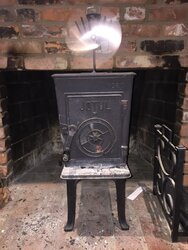I currently have a Jotul 602C in my masonry fireplace, with a stainless steel liner going up my chimney.
The 602C is a nice little stove, but it doesn't throw off enough heat for my purposes, and I'm looking for an upgrade. Some considerations...
- I'd like to get something used (hence, my post on this forum)
- The fireplace opening is 26 1/2" high, 37" wide, and 22" deep. The hearth sticks out 18" from the opening.
- I want to tie into the stainless steel liner in the chimney.
- If it matters, I'm located in Northeast Ohio.
- I'm willing to do some modification, like shortening legs, if necessary.
Any thoughts? I thought a Jotul 118 sitting on the hearth with the flue going into one of the side ports would be nice, but I don't know if I can safely lower one enough to make it work.
The 602C is a nice little stove, but it doesn't throw off enough heat for my purposes, and I'm looking for an upgrade. Some considerations...
- I'd like to get something used (hence, my post on this forum)
- The fireplace opening is 26 1/2" high, 37" wide, and 22" deep. The hearth sticks out 18" from the opening.
- I want to tie into the stainless steel liner in the chimney.
- If it matters, I'm located in Northeast Ohio.
- I'm willing to do some modification, like shortening legs, if necessary.
Any thoughts? I thought a Jotul 118 sitting on the hearth with the flue going into one of the side ports would be nice, but I don't know if I can safely lower one enough to make it work.


